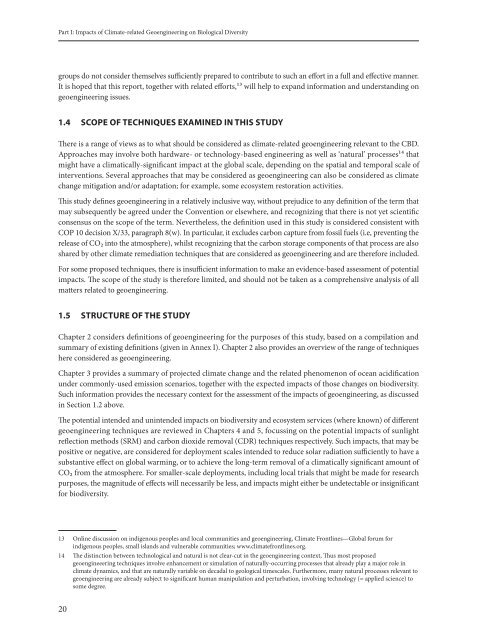cbd-ts-66-en
cbd-ts-66-en
cbd-ts-66-en
Create successful ePaper yourself
Turn your PDF publications into a flip-book with our unique Google optimized e-Paper software.
Part I: Impac<strong>ts</strong> of Climate-related Geo<strong>en</strong>gineering on Biological Diversity<br />
groups do not consider themselves suffici<strong>en</strong>tly prepared to contribute to such an effort in a full and effective manner.<br />
It is hoped that this report, together with related effor<strong>ts</strong>,13 will help to expand information and understanding on<br />
geo<strong>en</strong>gineering issues.<br />
1.4 SCOPE OF TECHNIQUES EXAMINED IN THIS STUDY<br />
There is a range of views as to what should be considered as climate-related geo<strong>en</strong>gineering relevant to the CBD.<br />
Approaches may involve both hardware- or technology-based <strong>en</strong>gineering as well as ‘natural’ processes14 that<br />
might have a climatically-significant impact at the global scale, dep<strong>en</strong>ding on the spatial and temporal scale of<br />
interv<strong>en</strong>tions. Several approaches that may be considered as geo<strong>en</strong>gineering can also be considered as climate<br />
change mitigation and/or adaptation; for example, some ecosystem restoration activities.<br />
This study defines geo<strong>en</strong>gineering in a relatively inclusive way, without prejudice to any definition of the term that<br />
may subsequ<strong>en</strong>tly be agreed under the Conv<strong>en</strong>tion or elsewhere, and recognizing that there is not yet sci<strong>en</strong>tific<br />
cons<strong>en</strong>sus on the scope of the term. Nevertheless, the definition used in this study is considered consist<strong>en</strong>t with<br />
COP 10 decision X/33, paragraph 8(w). In particular, it excludes carbon capture from fossil fuels (i.e, prev<strong>en</strong>ting the<br />
release of CO2 into the atmosphere), whilst recognizing that the carbon storage compon<strong>en</strong><strong>ts</strong> of that process are also<br />
shared by other climate remediation techniques that are considered as geo<strong>en</strong>gineering and are therefore included.<br />
For some proposed techniques, there is insuffici<strong>en</strong>t information to make an evid<strong>en</strong>ce-based assessm<strong>en</strong>t of pot<strong>en</strong>tial<br />
impac<strong>ts</strong>. The scope of the study is therefore limited, and should not be tak<strong>en</strong> as a compreh<strong>en</strong>sive analysis of all<br />
matters related to geo<strong>en</strong>gineering.<br />
1.5 STRUCTURE OF THE STUDY<br />
Chapter 2 considers definitions of geo<strong>en</strong>gineering for the purposes of this study, based on a compilation and<br />
summary of existing definitions (giv<strong>en</strong> in Annex I). Chapter 2 also provides an overview of the range of techniques<br />
here considered as geo<strong>en</strong>gineering.<br />
Chapter 3 provides a summary of projected climate change and the related ph<strong>en</strong>om<strong>en</strong>on of ocean acidification<br />
under commonly-used emission sc<strong>en</strong>arios, together with the expected impac<strong>ts</strong> of those changes on biodiversity.<br />
Such information provides the necessary context for the assessm<strong>en</strong>t of the impac<strong>ts</strong> of geo<strong>en</strong>gineering, as discussed<br />
in Section 1.2 above.<br />
The pot<strong>en</strong>tial int<strong>en</strong>ded and unint<strong>en</strong>ded impac<strong>ts</strong> on biodiversity and ecosystem services (where known) of differ<strong>en</strong>t<br />
geo<strong>en</strong>gineering techniques are reviewed in Chapters 4 and 5, focussing on the pot<strong>en</strong>tial impac<strong>ts</strong> of sunlight<br />
reflection methods (SRM) and carbon dioxide removal (CDR) techniques respectively. Such impac<strong>ts</strong>, that may be<br />
positive or negative, are considered for deploym<strong>en</strong>t scales int<strong>en</strong>ded to reduce solar radiation suffici<strong>en</strong>tly to have a<br />
substantive effect on global warming, or to achieve the long-term removal of a climatically significant amount of<br />
CO2 from the atmosphere. For smaller-scale deploym<strong>en</strong><strong>ts</strong>, including local trials that might be made for research<br />
purposes, the magnitude of effec<strong>ts</strong> will necessarily be less, and impac<strong>ts</strong> might either be undetectable or insignificant<br />
for biodiversity.<br />
13 Online discussion on indig<strong>en</strong>ous peoples and local communities and geo<strong>en</strong>gineering, Climate Frontlines—Global forum for<br />
indig<strong>en</strong>ous peoples, small islands and vulnerable communities; www.climatefrontlines.org.<br />
14 The distinction betwe<strong>en</strong> technological and natural is not clear-cut in the geo<strong>en</strong>gineering context, Thus most proposed<br />
geo<strong>en</strong>gineeering techniques involve <strong>en</strong>hancem<strong>en</strong>t or simulation of naturally-occurring processes that already play a major role in<br />
climate dynamics, and that are naturally variable on decadal to geological timescales. Furthermore, many natural processes relevant to<br />
geo<strong>en</strong>gineering are already subject to significant human manipulation and perturbation, involving technology (= applied sci<strong>en</strong>ce) to<br />
some degree.<br />
20


